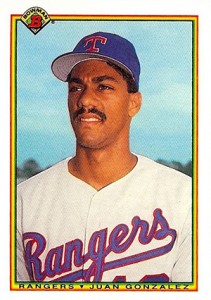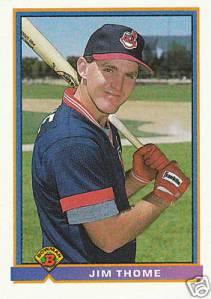
The 1930’s saw a crowded marketplace for baseball cards as a result, Bowman’s first trading card releases were focused on non-sport topics including the hugely successful and still popular “Horrors of War”.
 company’s own line of baseball cards. For three consecutive years the company produced the now famous and immensely popular Play Ball sets. Today, these sets remain some of the most iconic in the hobby.
company’s own line of baseball cards. For three consecutive years the company produced the now famous and immensely popular Play Ball sets. Today, these sets remain some of the most iconic in the hobby.
Unfortunately, World War II would put a damper on the country’s demand and availability of raw materials for bubble gum and trading card production for several years.
Skip to 1948 and the renamed Bowman Gum Company emerges as the market leader in the production of baseball cards starting with the ever popular 1948 Bowman Baseball card set. This was followed with the release of additional baseball card sets between 1949 and 1955.
History of Bowman Baseball Cards – Vintage Sets Image Gallery

The most valuable asset in the transaction for Topps wasn’t intellectual property or real estate but the often feuded over player contracts that had kept either Topps or Bowman from producing a complete and all inclusive baseball card set.
Fast forward 33 years to 1989 and Topps breathes new life into the long defunct and dormant brand. 1989 Bowman
What seemed like an homage to a classic vintage set, initially hurt sales because the cards did not fit in any standard card supplies at the time. However, without a doubt, Bowman was back!
The following year, seeing the error of its ways, Topps printed 1990 Bowman Baseball in traditional size with the cards measuring 2-1/2 by 3-1/2 inches. More rookies and prospects were added to the set most notably those of Sammy Sosa, Frank Thomas, Larry Walker, and Bernie Williams. Even more were added in 1991, including Jeff Bagwell, Chipper Jones, Ivan Rodriguez, Mike Mussina and Jim Thome.
The Bowman brand was developing a reputation for its high degree of rookie content but it would be the brand’s release in 1992 that earned it the moniker amongst collectors as being “Home of the Rookie Card”. 1992 Bowman Baseball delivered rookie cards of future stars, Trevor Hoffman, Carlos Delgado, Mariano Rivera, Mike Piazza, and Manny Ramirez.
History of Bowman Baseball Cards – Reborn Image Gallery
In 1994, Topps created the first in a long line of Bowman branded spinoffs. At $5 per pack it would be considered one of the first premium sets and was appropriately named 1994 Bowman’s Best – Premier Edition.

In addition to the sophomore release of Bowman’s Best, 1997 marks the debut of one of the hobby’s most beloved
By this point, Topps had firmly cemented the Bowman brand as the place where collectors could find the largest and most comprehensive list of rookie trading cards year in and year out. The brand now truly was “Home of the Rookie Card”.
In subsequent years, the Bowman name would be attached to the debut release of several other rookie and prospect oriented products. Starting in 2000, Bowman introduced Bowman Draft Picks & Prospects. This was followed by the release of Bowman Heritage in 2001 which paid tribute to the 1954 Bowman Black & White set. In 2005, Topps introduced collectors to the ultra high-end, super premium Bowman Sterling.
But then, something interesting happened.
In an attempt to add clarity to the definition of a rookie card, beginning in 2006, Topps and the Major League Baseball Players Association agreed to make changes to how a player’s rookie card would be determined and designated as such in future baseball card releases.

However, the idea of clarifying the rookie card definition was convoluted when the agreement allowed for Topps to continue to produce licensed prospect cards. This meant that players who were still in the minor leagues could be included on the checklist along with current MLB players. The distinguishing difference being, that those cards could not be numbered as part of the regular base set. These cards were, and continue to be coded with an alpha-numeric designation.
So much for clarifying the issue.
The impact this had on the Bowman brand was that it’s long recognized tag line, “The Home of the Rookie Card” became a moot point. While Topps still obviously maintains ownership of the tag line, it is used only sparingly in the brands’ marketing.
Today’s savvy collectors recognize that regardless of what year a player gets an arbitrarily decided logo, a player’s first licensed card with them adorned in the professional uniform, even if that uniform is from a minor league affiliate, constitutes the player’s defacto rookie card.
The market clearly reflects this to be true as often times, a player’s first cards appear in the hobby years before their official rookie card. These early cards are the ones that carry the greatest demand and therefore have the strongest value on the secondary market. In that sense, Bowman has always and will always be “Home of the Rookie Card”, regardless of whether or not those cards are accompanied by the official RC logo.
As the Bowman brand continued to expand over the following years, Topps introduced Bowman Originals, Bowman Inception and Bowman Platinum. These brands were all designed to deliver a higher-end feel and content without the price of the brand’s premium product, Sterling.
Through the years, some of the most valuable and iconic cards in the modern age of collecting can be attributed to Bowman. From the infamous 2001 Bowman Chrome Autographed card of Albert Pujols to the 2014 Bowman Chrome Prospects Auto of Kris Bryant and countless cards in between.
With Topps creativity, a deep talent pool of future stars and a timeless brand like Bowman, collectors have much to look forward to in the coming years.
- 2024 Fyre Ballgame Relics - April 25, 2024
- 2023-24 Panini Select NBA Basketball Cards Checklist - April 25, 2024
- 2024 Topps Series 2 Baseball Cards RETAIL - April 24, 2024























